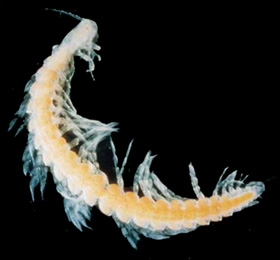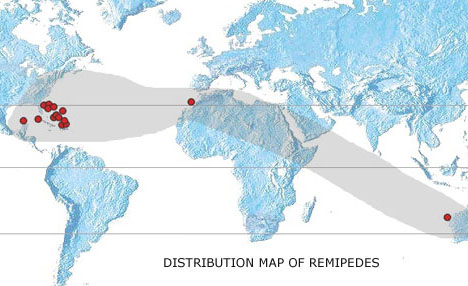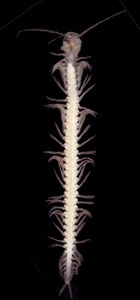Remipedes are hermaphroditic crustaceans that are exclusively known from anchialine,
coastal cave systems, i.e., caves connected with sea water via cracks, tunnels or tubes.
All
currently recognized taxa occur in tropical or subtropical environments in the Caribbean
region (13 species), Western Australian (1 species) and the Canary Islands (1 species) [from: Koenemann et al., 2004] ( www.cornellpress.cornell.edu).
The
greater Caribbean region, including the Yucatan Peninsula, is characterized by a high and
relatively dense taxonomic diversity of Remipedia. For example, several cave systems on
the Bahamas Islands are inhabited by sympatric remipedes, with up to six species and
three genera (Koenemann et al., 2003; unpublished data).
The first remipede was discovered in a cave on the Bahamas Islands (Yager, 1981).
Between 1981 and 2003, 14 new remipedes were discovered, all of which inhabit anchialine caves. At present, there are two families, the Godzilliidae Schram, Yager & Emerson,
1986, with three monotypic genera, and the Speleonectidae Yager, 1981, composed of nine
species in three genera.
They are free-swimming, troglobitic crustaceans, typically living in low-oxygen, brackish waters in marine caves; particularly they are
widely distributed in anchialine habitats linked to the ancient Tethys Sea (West Indies, Bahamas, Mexico, Cuba, Canary Islands, Cape Range Peninsula, Western Australia).
"Among the diversity of crustacean body plans, the
class Remipedia is indeed a ‘class apart’ distinguished by
a set of unique features. Remipedes are hermaphroditic
crustaceans that occur exclusively in subterranean
marine environments. The head region of these stygobionts
is armed with three pairs of powerful, raptorial
limbs. However, it is their long, homonomously
segmented trunk bearing biramous, paddle-shaped
appendages (Fig. 1A) that has led to the prevalent view
that remipedes are primitive crustaceans, although this
assumption has not yet been veri.ed or falsi.ed
convincingly. For example, the results of our ongoing
‘basal’ crustaceans (Schram and Koenemann 2004).
Recent comparative studies of cerebral structures in
arthropods suggest a sister-group relationship between
Malacostraca and Remipedia (Fanenbruck et al. 2004;
Harzsch 2004).
It certainly adds to the fascination of remipede
crustaceans that this group is relatively new to science.
The first remipede was discovered in an anchialine cave
on the Bahamas Islands (Yager 1981). Between 1980
and 2005, 17 more remipedes have been discovered,
including a new family (Koenemann et al. 2007)" (from: Koenemann, Schram, Honemann & Iliffe, 2007).
 Speleonectes gironensis (Cuba)

Koenemann, S., Iliffe, T.M., van der Ham, J., 2003. Three new species of remipede crustaceans (Speleonectidae) from Great Exuma, Bahamas Islands. Smithson. Contrib. Zool. 72, 227–252. Koenemann, S., Iliffe, T.M., Yager, J., 2004. Kaloketos pilosus, a new genus and species of Remipedia (Crustacea) from the Turks and Caicos Islands. Zootaxa 618, 1–12. Koenemann et al. 2009. A new, disjunct species of Speleonectes (Remipedia, Crustacea) from the Canary Islands. Marine Biodiversity, 2009 Koenemann, S., Iliffe, T.M., van der Ham, J., 2007. Micropacteridae, a new family of Remipedia (Crustacea) from the Turks and Caicos Islands. Org. Divers. Evol. 7, 52–54. Schram, F.R., 1983. Remipedia and crustacean phylogeny. Crust. Issues 1, 23–28. Schram, F.R., Yager, J., Emerson, M.J., 1986. Remipedia, part 1: systematics. Proc. Mem. San Diego Soc. Nat. Hist. 15, 1–60. Yager, J., 1981. A new class of Crustacea from a marine cave in the Bahamas. J. Crustacean Biol. 1, 328–333. Daenekas J., , T. Iliffe, J. Yager & S. Koenemann. 2009. Speleonectes kakuki, a new species of Remipedia (Crustacea) from anchialine and sub-seafloor caves on Andros and Cat Island, Bahamas. Zootaxa 2016: 51–66 Yager, Jill. 1981. Remipedia, a new class of crustacea from a marine cave in the Bahamas.J. Crust. Biol., 1 (3): 328-333.
Yager, J.. 1989. Pleomothra apletocheles and Godzilliognomus frondosus, two new genera and species of remipede crustaceans (Godzilliidae) from anchialine caves of the Bahamas. Bulletin of Marine Science, 44(3):1195-1206. Yager, J. 1991. The remipedia (Crustacea): recent investigations of their biology and phylogeny. Verh. Dtsch. Zool. Ges., 84: 261-269. Yager, J. 1991. The biology of the crustacean class Remipedia, with emphasis on internal anatomy. Proc. of the National Speleological Society Annual Meeting, July 1991; in: NSS Bull. Vol.53 Nr.2 (publ. 1992):113. Yager, J., Carpenter, J.H., 1999. Speleonectes epilimnius new species (Remipedia, Speleonectidae) from surface waters of an anchialine cave on San Salvador Island, Bahamas. Crustaceana 72, 965–977. Yager, J., Schram, F.R., 1986. Lasionectes entrichoma, n. gen., n. sp. (Crustacea, Remipedia) from anchialine caves in the Turks and Caicos, B.W.I. Proc. Biol. Wash. Soc. 99, 65–70. Yager J. & W. F. Humphreys. 1996. Lasionectes exleyi, sp. nov., the First Remipede Crustacean Recorded from Australia and the Indian Ocean, with a Key to the World Species. Invertebrate Taxonomy, 10: 171-187
© Dennis Williams
|

